I was reminded, following last week’s post on challenges faced by wind energy, that some people seem to view energy technologies like football teams. They have their favorite, who they support no matter how bad the losing position. And of course they also have their arch rivals, to be cheered against no matter what. Above all, critique of a favored technology is taken as a personal affront.
The reality is that the global energy mix is going to be “all-of-the-above” (should we call that ALLOTA?)1 as far as we can reliably project into the future, with the possible exception of coal, which sits firmly in the relegation zone. Of course, there are may possible configurations of ALLOTA across the dimensions of cost, reliability, accessibility, and environmental impact, including carbon dioxide emissions.
Today, I take a look at solar energy technologies.
At some point I stopped using the word “renewables” to lump together wind and solar due to my pessimistic views of wind and optimistic views of solar. I don’t think it will be too long until conventional wisdom considers wind energy like we look back at the Blackberry phone,2 and solar like the iPhone.
Today I discuss three reasons why I am very bullish on solar energy technologies — solar is scalable, solar is cheap and getting cheaper, and solar is safe, simple, and popular.
Solar is Scalable
A homeowner can put solar panels on their roof. They can’t do that with a wind turbine, a hydroelectric dam, or a powerplant.3 That means that solar can be “right-sized” in a way that wind cannot.
There are places around the world where it is possible to locate a 22-sqaure mile utility scale solar farm, such as the Bhadla Solar Park pictured below from satellite, which is in the desert of western Rajasthan, India. That massive solar park has a capacity of about 2.25 gigawatts, which in terms of generation (assuming a capacity factor of ~30%) would be about the same as a single 700 MW nuclear facility.
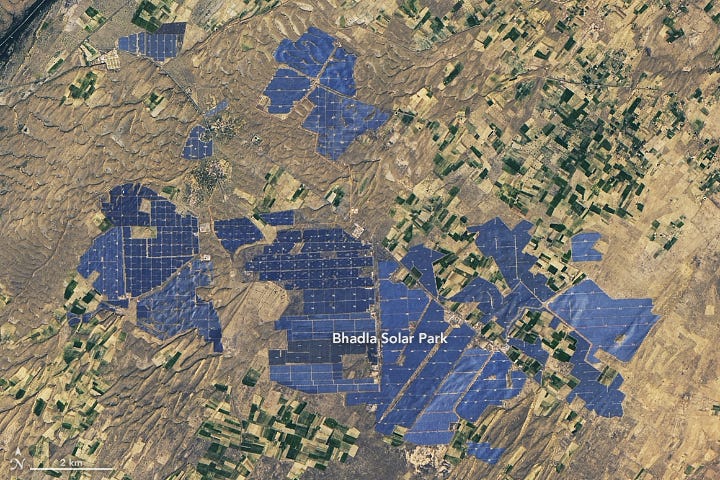
If solar only was possible at the utility scale, then it would suffer similar shortfalls to wind. But solar generation can be deployed from the kilowatt to the gigawatt scale, and that opens up many opportunities for deployment. In the U.S., the Energy Information Agency (EIA) reports that about one third of solar generation comes from small-scale solar (defined as less than 1 MW capacity), as shown below.
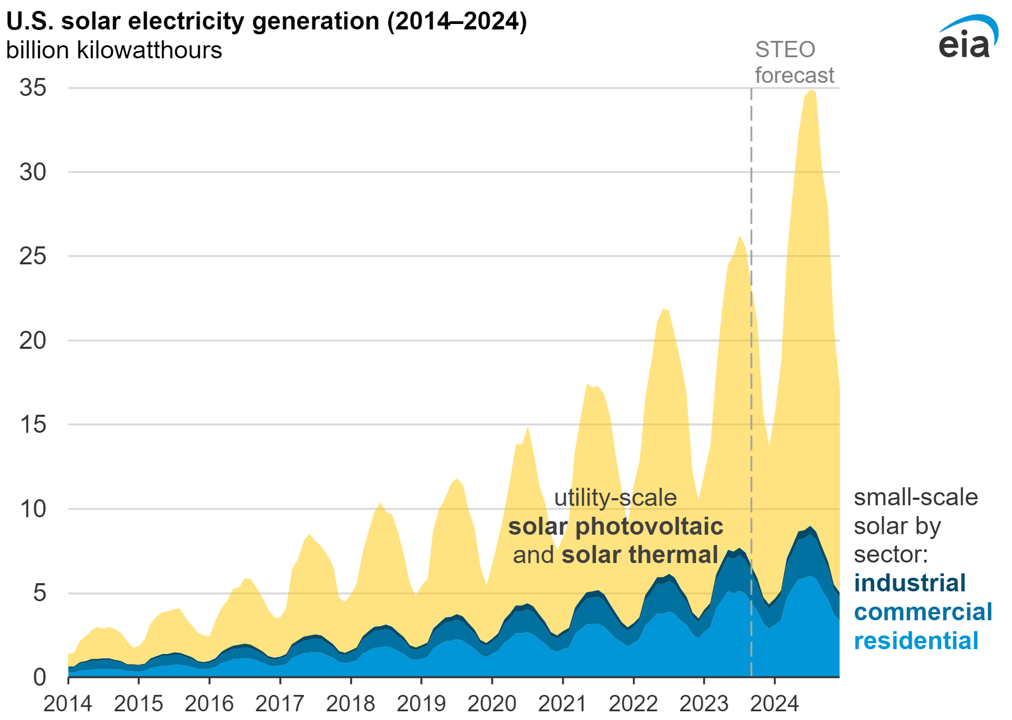
Compared to the rest of the world, solar the U.S. is small potatoes. According to BloombergNEF, solar installations are expected to boom around the world, driven mainly by China, as you can see below.
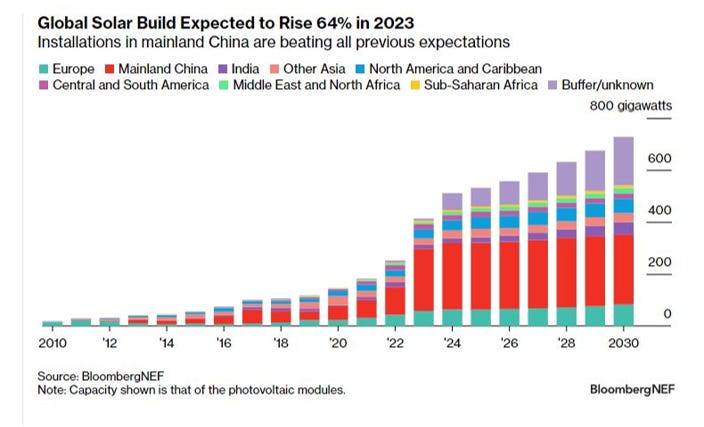
Solar is Cheap and Getting Cheaper
The Iron Law of climate policy means that it is difficult to motivate an energy transition by intentionally making types of energy appreciably more expensive. But is also means that when clean energy becomes cheaper, it readily gobbles up market share, eventually displacing dirtier and more expensive energy.
The figure below shows the plummeting price of solar modules over the past half century.
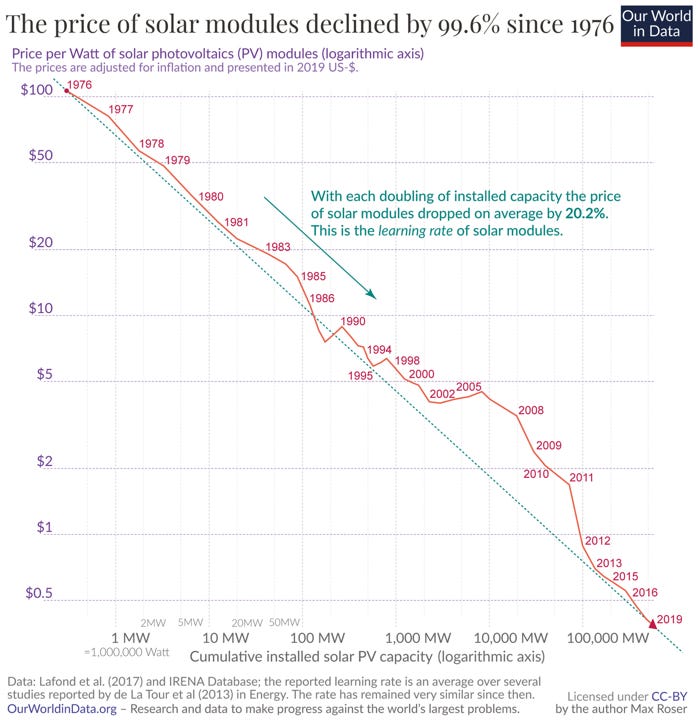
The low costs of solar energy, which are positioned to drop even further, has led some in the U.S. to question — quite fairly — why federal subsidies for wind energy are necessary today and far into the future. With or without U.S. subsidies, solar costs should be expected to continue to drop, motivating further deployment, which will lead to greater reductions in costs — a virtuous cycle.
Even if solar were free, the technology will always have an intermittency problem when the sun doesn’t shine. The New York Times explained last week that massive battery storage can smooth over demand, but it cannot address intermittency with today’s technologies:
Today’s lithium-ion batteries typically only deliver power for two to four hours before needing to recharge. If costs keep falling, battery companies might be able to extend that to eight or ten hours (it’s a matter of adding more battery packs) but it may not be economical to go far beyond that, said Nate Blair, an energy storage expert at the National Renewable Energy Laboratory.
That means additional long-duration storage technologies could be needed. If California wants to rely largely on renewable energy, it will have to handle weeklong periods where there’s no wind and little sun. Another challenge: There’s far more solar power available in summer than in winter, and no battery today can store electricity for months to manage those seasonal disparities.
As solar gets cheaper, it will see continued expansion, but accompanying that expansion will be the associated costs of reliable back-up generation, which today means natural gas. Even though natural gas is a fossil fuel, the expanded use of solar backed up by gas has considerable potential to reduce emissions, especially in places where that combo displaces coal generation. The low costs of solar mean that we should expect to see more such displacement.
Solar is Safe, Simple, and Popular
Solar energy is, according to a review by Our World in Data, the safest source of energy production, as measured by deaths per terawatt-hour of production. The only other energy production technology that is close is nuclear energy. I’m also very bullish on nuclear technologies, also because they are incredibly safe, but the reality is that many people have dread risk fears about nuclear energy. These fears are not backed by evidence, but they are legitimate and will limit the expansion of nuclear energy in many places.
Searching Google Scholar, I have not been able to find a single paper addressing fears of solar energy. There are of course concerns about solar supply chains, solar waste, and risks to solar installations but these issues are common across all energy technologies.
A 2023 survey by Glocalities of 21,000+ people in 21 countries found solar energy to be the most favored energy technology, and overwhelmingly so, with 68% favoring solar over other technologies, as shown in the figure below.
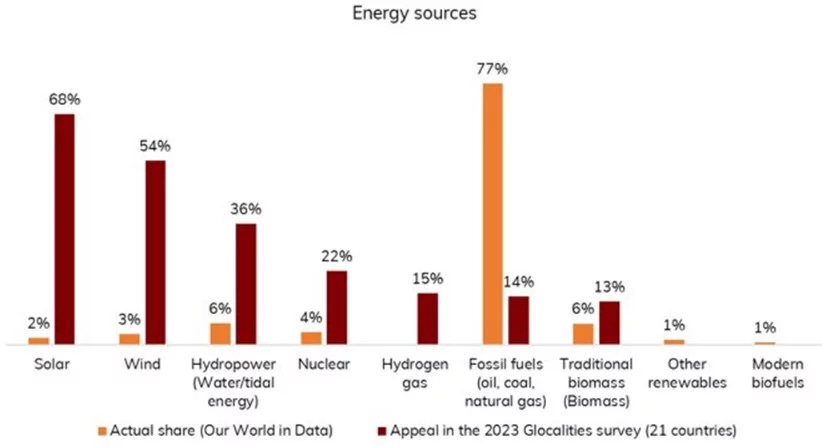
The strong public support for solar and lack of public fears mean that among energy technologies, solar has strong political tailwinds that are unique in the energy space. Correspondingly, the ongoing expansion of solar generation will face much less opposition than proposed new wind and nuclear.4 Of course, the fact that effective solar deployment also means more gas back-up may result in greater opposition in the future from those who believe that we can just stop fossil fuel use.
Compared to solar energy technologies, wind technologies appear like a convoluted series of Rube Goldberg devices. To be sure, modern wind turbines are a testament to human ingenuity and technological prowess. But they are also massive installations with many moving parts often exposed to harsh conditions — offshore wind in particular. Solar technologies are elegantly simple in comparison.
Energy forecasts are a mug’s game — we all know that — but I’m going to make a projection anyway. Solar energy technologies are going to become increasingly favored over wind technologies. Sure, wind will continue to have a role in the global energy mix, but that role as a proportion of global electricity generation will soon be dwarfed by solar. Arguably, the data on global electricity generation shows that trend is already underway, as shown below.
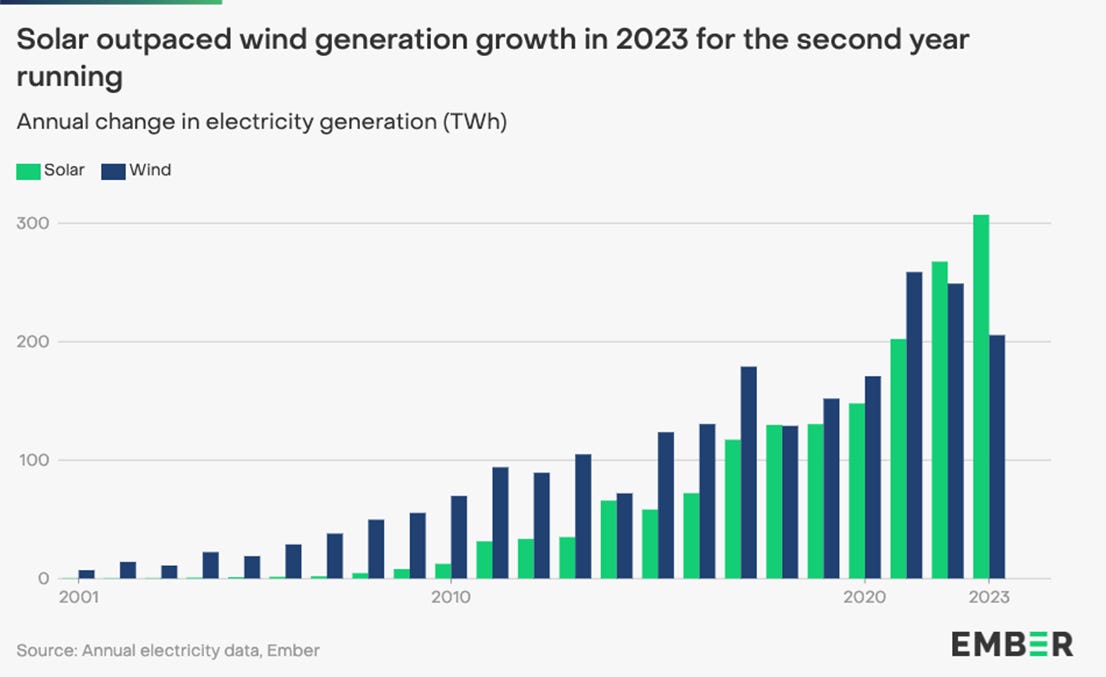
❤️Click the heart if you think the sun is cool but also hot!
I welcome your comments, critique, suggestions, pointers, and engagement! THB is reader supported — Specifically, THB is an experiment in a new way to support independent research and writing. Read more about this experiment here. The sustainability of THB depends on your support, so please consider subscribing and if you are a subscriber, please consider upgrading. For those who are already paid subscribers — thank you!
Credit to John B in the comments for ALLOTA!
Disclosure: I loved my original Blackberry. But it was properly displaced by a superior product.
Homeowners can burn wood in a fireplace or stove, meaning that wood is also scalable. But wood has other downsides which is why wood energy is displaced when alternatives are available.
Less, but not none. Utility-scale solar is vulnerable to local opposition.





"That massive solar park has a capacity of about 2.25 gigawatts, which is about the same as a single nuclear facility."
It has a *capacity* of 2.25 gigawatts...at full sun. About the same as a single nuclear facility, 24/7.
It has an *average output* of one-fourth of that 2.25 gigawatts...or 560 megawatts...about the same as one-fourth of that 2.25 gigawatt nuclear facility.
Let me take a moment to thank everyone
This (and the wind post) have had just extraordinary comments and discussions
Not everyone agrees with each other, or me, and hopefully everyone learns
So thanks!